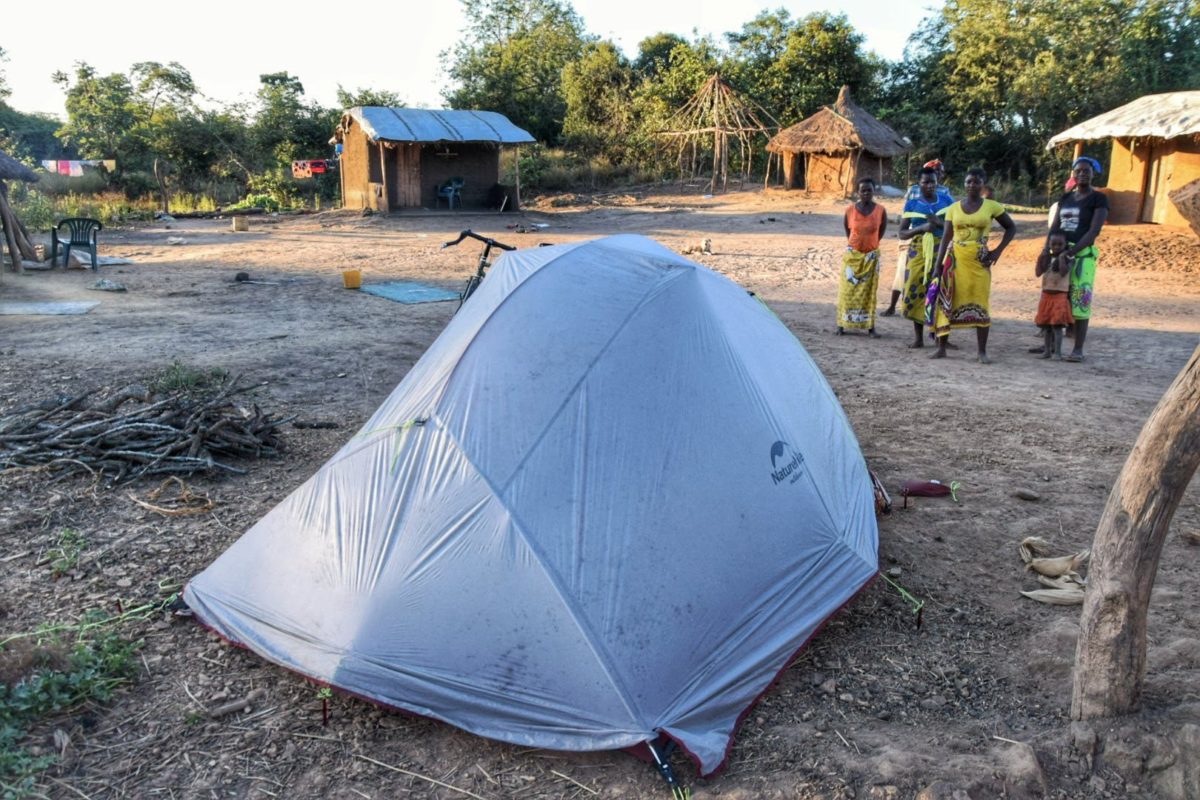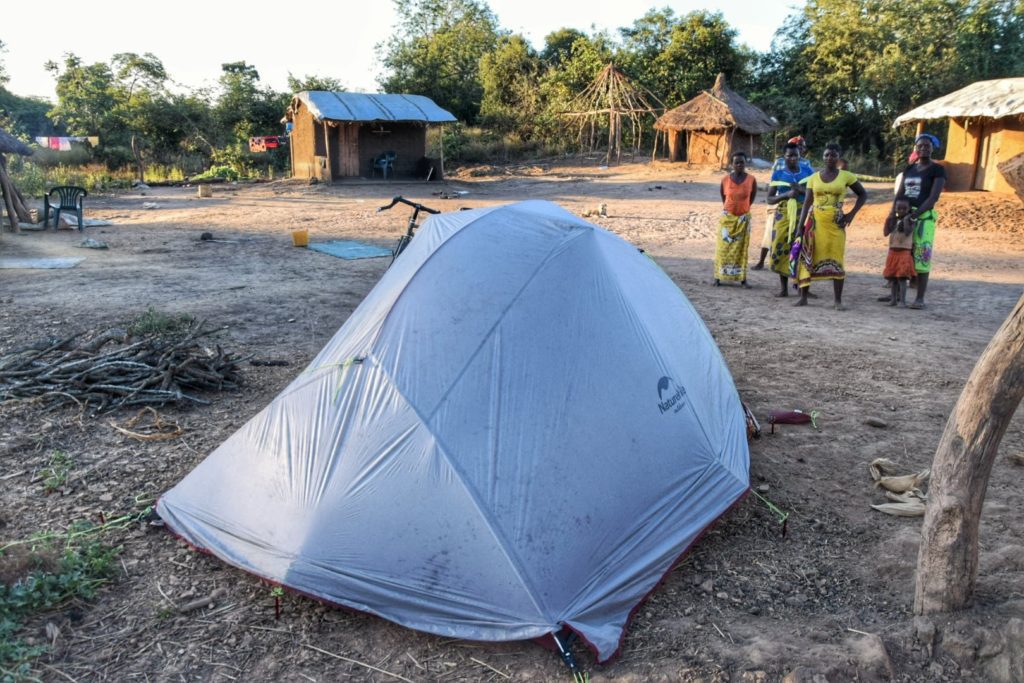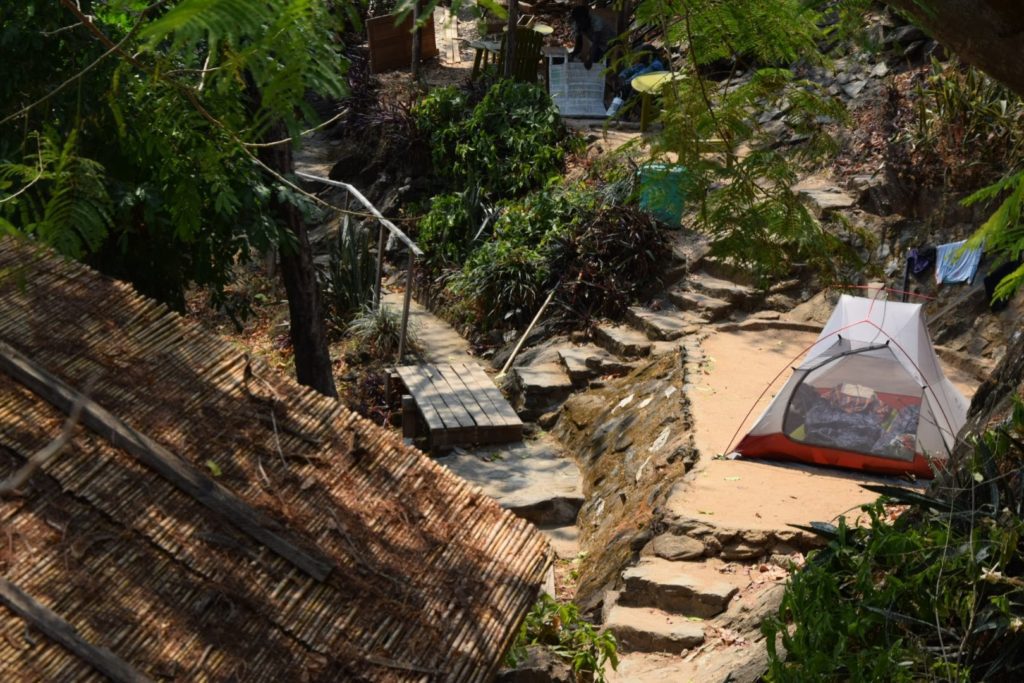Last Updated on 27 April 2024 by Cycloscope
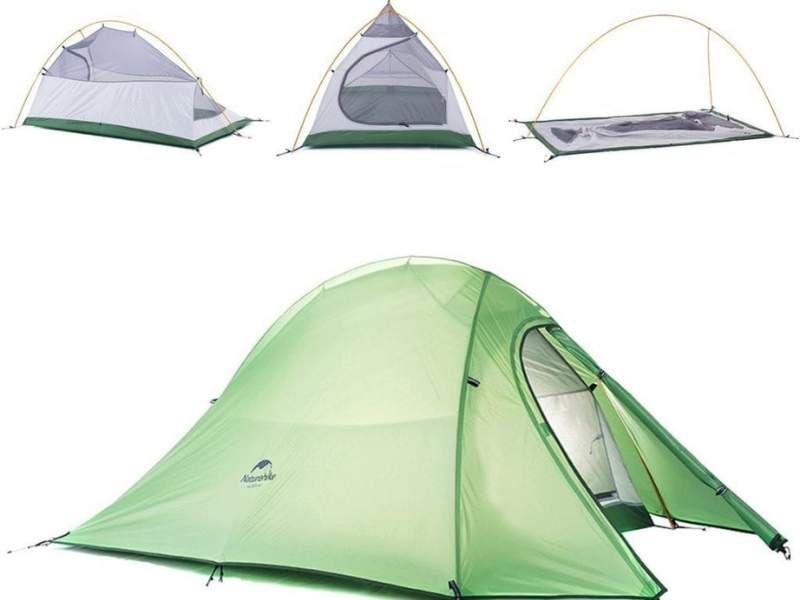
Naturehike Cloud-Up 1 VS 2 VS 3 person! An opinion review after a 3 year test. 4 seasons vs 3 seasons
Is this the best budget lightweight tent?
If you landed on this page you’re probably wondering if the Naturehike Cloud Up is a good tent or not… then look no further and dive into our Naturehike Cloud-Up review!
We have tested the Nature Hike Cloud Up 2 and 3-person versions for a total of three years of bike touring through Europe and Southern Africa, and in this review, we’ll give you our unbiased, expert opinion about the Naturehike Cloud Up camping tents.
NatureHike is a Chinese brand that is quickly making its way in the outdoor world thanks to the high quality of its products, its low price tags, and great customer service. If you want to have a look at more of their options check our Naturehike Tents REVIEW! 11 Tents Compared for 2024.
In this review, we are going to compare the more popular Naturehike Cloud-Up 2-person tent with the Cloud-Up 1-man and Cloud-Up 3-persons. We’ll also analyze the difference between the 3-season and 4-season versions.
We’ll go through the materials, design strengths and flaws, performance, durability, and all the other info you might need to decide if the Cloud-Up is the right tent for you. So keep on reading!
Naturehike Cloud Up Review
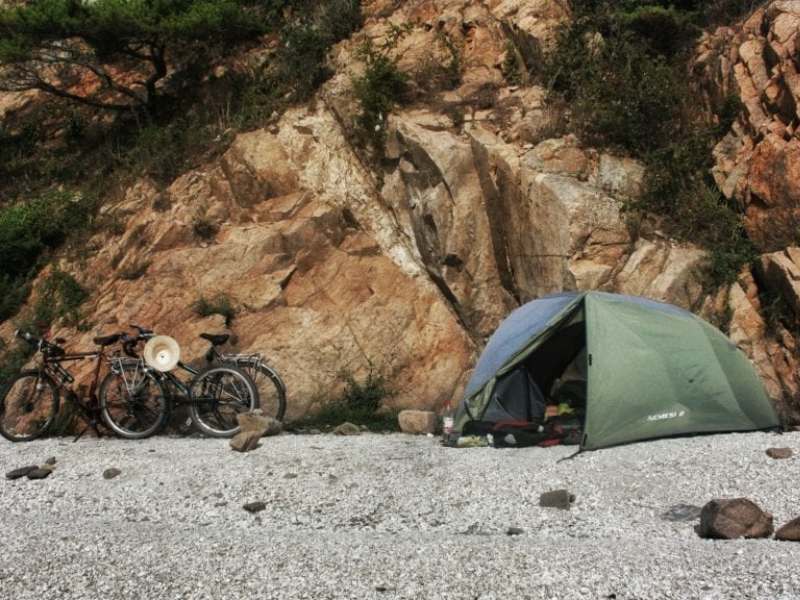
Although we briefly tested the 2-man version, this field test will refer mostly to the Naturehike Cloud Up 3, which we have used extensively for about 3 years, from the Arctic Circle to the heat of Southern African savannah.
How to set up a Naturehike Cloud Up tent
The setup of a Cloud Up is really super easy, even the 3-person version could be pitched by one person alone in less than 10 minutes, 5 minutes will be enough once you get used to it.
The poles are all connected in one single bundle: a central rod that keeps the roof up and splits into two diagonal poles both at the front end (longer rods) and at the back (shorter). A short, perpendicular pole is hinged at the center of the long central pole and has the function of tensing the upper end of the tent.
The poles basically come together when released/unfolded, requiring the user to secure them in place.
The inner tent and fly sheet have aluminum-laminated holes attached to a short but sturdy fabric strip at the corners, it’s here that the pole’s ends are stuck in place, forcing them to bend in shape.
The inner fly is then connected to the poles with simple plastic hooks (recently upgraded to double-sided hooks). Those lift the inner mesh and put the tent in shape.
The rainfly is then positioned on top of the poles and secured with hooks, pegs, and eventually, the included tension ropes if the wind seems a concern.
The same procedure is used for the 1, 2, and 3-person versions, with the only difference being that the 1-man Cloud Up doesn’t have the “back legs” and thus needs to be necessarily tensioned with pegs (or pulling ropes).
Is the Naturehike Cloud Up really waterproof?
The short answer is yes, the proper answer will require a few more words. We slept in our Cloud-Up under the most hectic thunderstorms and downpours and never experienced any leak of the sort, that’s during the course of three whole years, so I would say the waterproofness is quite durable!
What we mention about condensation in the 3-season VS 4-season paragraph below though, is especially true for the tent floor, both for the skirt and the non-skirted version.
If put at direct content with even slightly wet ground, condensation will happen and you’ll have a wet tent floor. That’s one of the two main reasons why you should always use the included footprint when pitching your tent on a natural surface – the other reason is obviously to protect the tent floor from being punctured, which will compromise the overall performance.
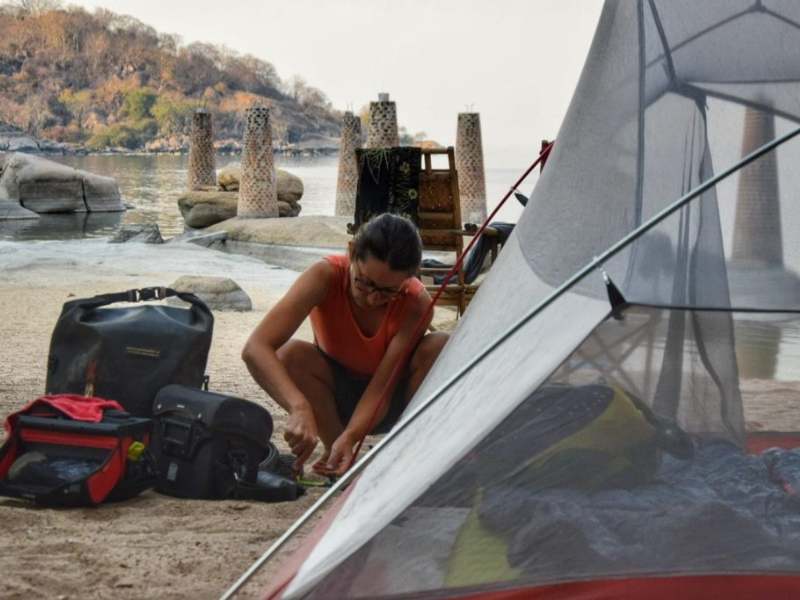
Cloud Up against the wind
The only real failure our Naturehike Cloud Up encountered in its long and successful career is indeed against the wind – only one failure, but an important one.
Under a terrible wind storm in the Arctic Circle in Norway, a pole snapped and tore the flysheet. The pole was irreparably broken in two, with small splinters.
That said, our Cloud-Up endured a lot in Norway, especially another strong storm about a week before that might have weekend the pole. Also, there might have been some over-tensioning, which can cause problems with strong irregular winds.
Naturehike anyway, replaced the flysheet in a few days and even gave us a contribution for the nights we couldn’t camp and had to pay for accommodation.
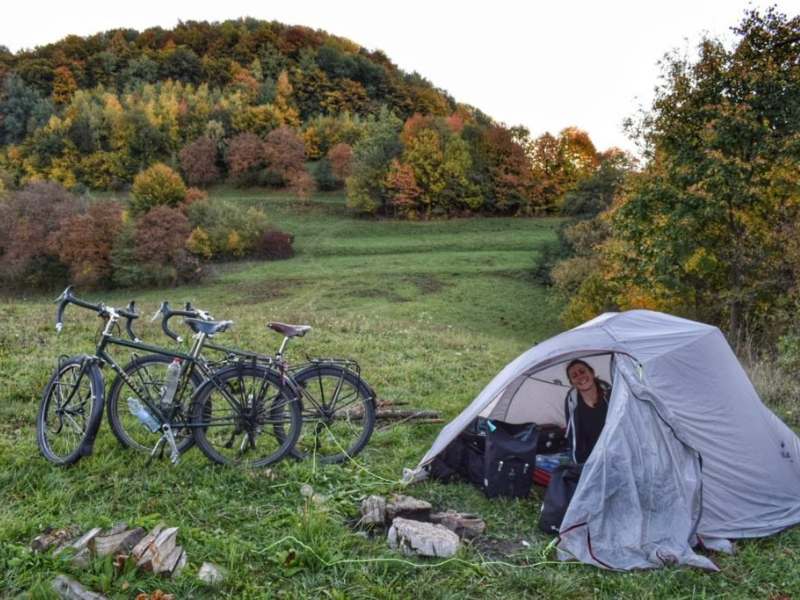
Naturehike Cloud Up Materials
Like most Naturehike tents, the Cloud Up comes in two different versions which differ in materials. A cheaper 210T polyester fabric or a slightly more pricey 20D nylon version.
The Taffeta-210T is a high-quality polyester fabric – fast-drying, light, soft and durable.
When we see 20D nylon we are watching a nylon fabric where the D stands for denier, so 20D stands for 20 denier nylon.
Denier is a unit used to measure the density of a fabric, based on the length and weight of yarn or fiber. A single strand of silk is considered 1 denier. The fibers in a 20-denier nylon fabric have over 4 times the diameter of the silk strand.
So what’s better 20D or 210T?
20D is lighter and more durable for its weight. 20D nylon has a waterproofness rate of 4000mm, which means it can withstand a 4-meter (4000mm) column of water before it starts to leak through the fabric.
210T polyester can only resist a 3000mm water pressure, despite being quite a lot thicker.
One downside of 20D is its slipperiness. It’s very common to find yourself sliding around a 20D tent floor – which is very annoying when your tent is pitched on slightly sloppy terrain.
Nylon also expands when wet, as much as 3.5% when soaked, while polyester does not expand or gain weight when it is wet. This problem is solved in most camping tents by treating the nylon fabric with a water-repellant such as silicone or DWR.
Moreover, nylon dries much faster compared to polyester, thanks to its being thinner and more breathable.
The inner igloo is the same in all CLoud-Up models, made of high-density mesh and nylon only for the floor and lower sides.
Poles are made of 7001 Aluminum alloy, lightweight, flexible, and reasonably strong. The pegs have a crossed section and are also quite sturdy, it’s rare to bend one and they can always be put back in shape with a hammer or a hard rock.
Naturehike Cloud Up 4-seasons VS 3-seasons
The only difference between the 4-season and 3-season versions of the Cloud-Up is the presence of what Naturehike likes to call a “skirt”.
This is simply an extension of the fly sheet that extends to the lower part all the way to the ground – while the 3-season version ends a few centimeters above the ground allowing for air exchange.
This simple expedient is meant to insulate the inner igloo from the air outside by reducing, or totally blocking, the flow of external air – the good thing is… it works.
The long gown of the rainfly acts as a wall insulating the air inside from the outdoor environment. As you stay inside your tent, your breath and overall body heat warm up the air inside, raising the tent’s inner temperature.
The more experienced of you might have a word floating around your mind: condensation.
And, unfortunately, you’re not wrong. Inhibiting air exchange with the outside brings up a temperature differential on the rainfly surface which in turn causes condensation – basic science baby.
The good thing is that the condensation remains on the flysheet walls and never drips, so you and your gear won’t get wet, just a bit more humid.
Needless to say, the 3-season version doesn’t have this issue.
If you’re debating whether to purchase the 4-seasons or 3-season version of the Naturehike Cloud Up check out:
> 3-Season Tents VS 4-Season Tents – What Should You Bring With You?

Cloud Up 1-Person VS 2-Persons VS 3P
The Cloud Up by Naturehike comes in three different sizes. A compact 1 person version – ideal for bikepacking and minimalist hiking – a two-person model – great for small couples – and a large 3-person version – the best option for couple’s extended trips.
The Cloud Up 1-person measures 82.7″ (210cm) in length, 43.3″ (110cm) in width on the head side 31.5″ (80cm) on the foot side, and 39.3″ (100cm) at its highest inner point.
The Cloud Up 2-person measures 82.7″ (210cm) in length, 51.2″ (130cm) in width on the head side 49.2″ (125cm) on the foot side, and 41.3″ (105cm) at its highest inner point.
The Cloud Up 3-person measures 82.7″ (210cm) in length,70.8″ (180cm) in width on the head side and 68.9″ (175cm) on the foot side, and 43.3″ (110cm) at its highest inner point.
The weights of the different models of Cloud Up are:
- 1-person: 3.3lbs (1.5kg)
- 2-persons: 3.09 (1.4kg) 20D version / 3.97lbs (1.8kg) 210T version / 4.18 (1.9kg) 4-seasons
- 3-persons: 4.62 (2.1kg) 20D / 5.07lbs (2.3kg) 210T / 5.29lbs (2.4kg) 4-seasons
Actual (mid-2023) prices for the Naturehike Cloud-Up go as follows:
- 1-person $134.95 (20D version) / $119.95 (210T)
- 2-persons $169.95 (20D version) / $129.95 (210T) / $179.95 (4-seasons)
- 3-persons $228.00 (20D version) / $165.00 (210T) / $242.00 (4-seasons)
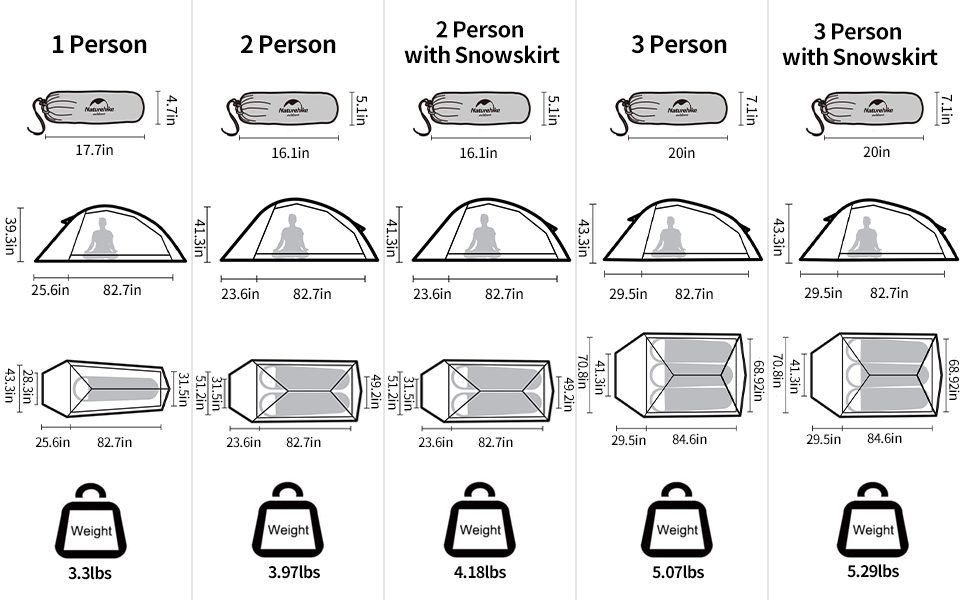
The color choices for the Naturehike Cloud Up
The Naturehike Cloud-Up comes in a decently wide choice of colors. Gray, Navy Blue, Olive Green, and Light Green for the 20D version – and Orange or Green for the 210T version.
Only Gray is available for the 4-season version with the skirt.
If you’re purchasing this tent with the intention of doing some wild camping, or even stealth camping, we recommend the less visible green version.
Naturehike Cloud-Up 2: Technical Specs
Naturehike Cloud-Up Review – Wrap Up
Overall this is one of the best budget backpacking tents, and certainly the best Naturehike tent so far.

